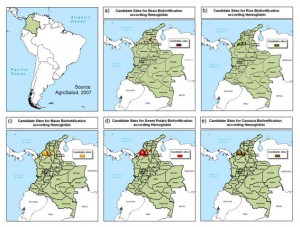Emmanuel Zapata Caldas, a geography student at the Universidad del Valle in Colombia, has won second prize at the XVIII National Geography Event for his work, carried out in collaboration with CIAT, on the spatial analysis of malnutrition in Latin America. Reproduced below are some of his results for Colombia, which he kindly made available to us (click to enlarge).
For this particular analysis, Emmanuel looked at the prevalence of anemia and used secondary data on poverty and agricultural production to identify sites in Colombia where the biofortification of different crops could have a significant impact on this aspect of malnutrition. Congratulations to Emmanuel for his prize, and his interesting work.
